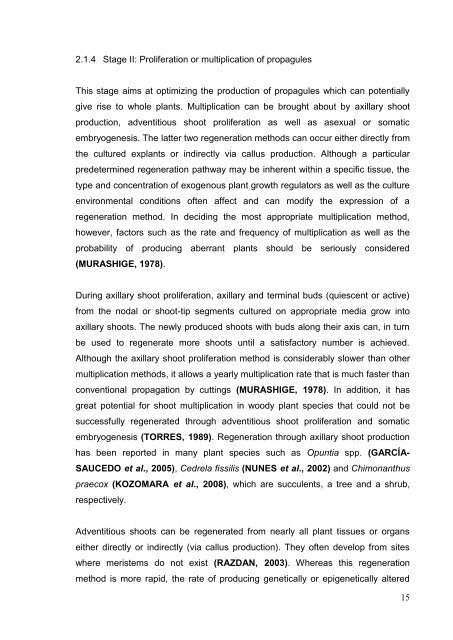Micropropagation and medicinal properties of Barleria greenii
Micropropagation and medicinal properties of Barleria greenii
Micropropagation and medicinal properties of Barleria greenii
You also want an ePaper? Increase the reach of your titles
YUMPU automatically turns print PDFs into web optimized ePapers that Google loves.
2.1.4 Stage II: Proliferation or multiplication <strong>of</strong> propagules<br />
This stage aims at optimizing the production <strong>of</strong> propagules which can potentially<br />
give rise to whole plants. Multiplication can be brought about by axillary shoot<br />
production, adventitious shoot proliferation as well as asexual or somatic<br />
embryogenesis. The latter two regeneration methods can occur either directly from<br />
the cultured explants or indirectly via callus production. Although a particular<br />
predetermined regeneration pathway may be inherent within a specific tissue, the<br />
type <strong>and</strong> concentration <strong>of</strong> exogenous plant growth regulators as well as the culture<br />
environmental conditions <strong>of</strong>ten affect <strong>and</strong> can modify the expression <strong>of</strong> a<br />
regeneration method. In deciding the most appropriate multiplication method,<br />
however, factors such as the rate <strong>and</strong> frequency <strong>of</strong> multiplication as well as the<br />
probability <strong>of</strong> producing aberrant plants should be seriously considered<br />
(MURASHIGE, 1978).<br />
During axillary shoot proliferation, axillary <strong>and</strong> terminal buds (quiescent or active)<br />
from the nodal or shoot-tip segments cultured on appropriate media grow into<br />
axillary shoots. The newly produced shoots with buds along their axis can, in turn<br />
be used to regenerate more shoots until a satisfactory number is achieved.<br />
Although the axillary shoot proliferation method is considerably slower than other<br />
multiplication methods, it allows a yearly multiplication rate that is much faster than<br />
conventional propagation by cuttings (MURASHIGE, 1978). In addition, it has<br />
great potential for shoot multiplication in woody plant species that could not be<br />
successfully regenerated through adventitious shoot proliferation <strong>and</strong> somatic<br />
embryogenesis (TORRES, 1989). Regeneration through axillary shoot production<br />
has been reported in many plant species such as Opuntia spp. (GARCÍA-<br />
SAUCEDO et al., 2005), Cedrela fissilis (NUNES et al., 2002) <strong>and</strong> Chimonanthus<br />
praecox (KOZOMARA et al., 2008), which are succulents, a tree <strong>and</strong> a shrub,<br />
respectively.<br />
Adventitious shoots can be regenerated from nearly all plant tissues or organs<br />
either directly or indirectly (via callus production). They <strong>of</strong>ten develop from sites<br />
where meristems do not exist (RAZDAN, 2003). Whereas this regeneration<br />
method is more rapid, the rate <strong>of</strong> producing genetically or epigenetically altered<br />
15

















